What do Robins Eat?
Robins are one of the UK’s favourite garden birds. And it is easy to see why. This gorgeous little visitor is surrounded by myth and folk law, immortalised in song, and strongly associated with that most wonderful time of the year – Christmas.
And whereas males can be aggressive to one another when feeding or defending their breeding territory, they are one of tamest British birds around humans, often feeding around people seemingly without a care in the world. It is no wonder thousands of us are so keen to attract this beautiful little visitor to our gardens.
What’s the best way to do that?
Why, food of course! There’s nothing like the promise of a good feed to encourage birds to flock to your garden. But to attract the species you love the most, you must put out the right type of food.
So, in this article, we take a look at what Robins like to eat.
A Robin’s Diet in the Wild
The first thing a lot of people don’t realise is that Robins are ground feeders. They will come to bird tables but are only rarely, if at all, seen at feeders. This behaviour is a result of their diet in the wild. Robins get most of their protein from insects so love to forage woodland floors, fields and gardens for worms, beetles, and any other creepy crawlies that cross their path.
It is also this behaviour that has led to the Robin’s reputation for being very tamest around people. They will often follow someone digging their garden with apparently no fear at all and can get really quite close to people. They do this because they’ve learned that digging the garden means worms are brought to the surface and following hot on the heels of the gardener often results in a juicy meal.
Some people take this association even further by encouraging Robins to feed from their hands, something they will often do if you are patient and offer the right kind of foods.
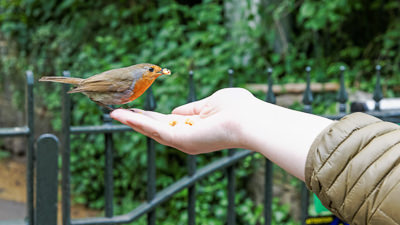
As well as insects, Robins love to dine on fruits, berries, seeds and nuts, which combine to give them the right amounts of protein, carbohydrates and fats they need to survive.
However, like all garden birds, Robins benefit most when their natural diet is supplemented by premium quality wild bird feed, helping them to not just survive, but thrive.
Feeding Robins
We’ve already discovered that Robins are predominantly ground feeders and rarely take food from hanging feeders. So, it is important that you either use ground trays (if you’re concerned about keeping your lawn clean and tidy), a bird table, or scatter food on the ground for them to find.
Scatter feed under and around shrubs and hedge bottoms, as this gives the birds shelter from the elements, particularly in winter, and protection from predators.
Finally, it is always a good idea to put out food in more than one area. For example, try scattering our Robin & Songbird mix on the ground and on a bird table. That way, you’re less likely to attract two males to the table, which will probably spend more time fighting than feeding!
You can also put Robin & Songbird mix in feeders to attract other species. Tits, Sparrows and Wrens particularly love this blend.
What to Feed Robins
Due to insects making up the bulk of a Robin’s diet, they will love Dried Mealworms or Dried Calciworms. One tip to make both these worms even more palatable is to soak them in water as this introduces valuable moisture into their diet. This is particularly valuable in springtime when adult birds are feeding young, as it makes the worms softer, and therefore easier, for their offspring to digest.
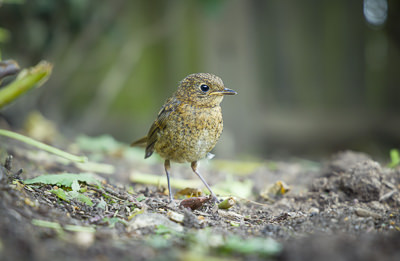
Juvenile robin or young baby European robin (erithacus rubecula) in a garden in spring, UK
Dried Calciworms, which are the larvae of the Black Soldier Fly, are generally considered an avian superfood as they contain around 50 times more calcium than other worms and insects.
This is crucial for maintaining a strong skeletal system and for egg development in the run up to nesting time.
Other individual foods Robins will love include Sunflower Hearts, Peanut Granules, and Suet Products which provide a great balance of fats and proteins. These enable birds to take on a lot of calories quickly and then move, which, being ground feeders, is one way they protect themselves against predators.
Pinhead Oatmeal is another excellent individual food to put out for Robins as it is high in carbohydrates, giving them slow release energy throughout the day.
Wild Bird Blends
When choosing a blend to feed to Robins, or any other species, pick a premium base blend that contains the majority of the nutrients they need in the right amounts. For Robins, we recommend our Robin & Songbird mix.
Robin & Songbird mix contains dried mealworms to provide fat and protein, as well as lots of small seeds which can be eaten quickly, which is vital for preventing predation.
The full ingredients list includes Sunflower Hearts, Pinhead Oatmeal, Peanut Granules, Yellow Millet, Dried Mealworms, and Vegetable Oil.
Robin & Songbird mix contains everything needed to keep these wonderful birds healthy and have them flocking to your garden.
Our Premium Wild Bird Food is also particularly good for Robins for the same reasons – it contains lots of high energy, small seeds, as well as suet.
However, Premium Wild Bird Food doesn’t contain Dried Mealworms, so if you are putting this out it is important to supplement with these or Dried Calciworms, to provide essential insectivorous proteins.
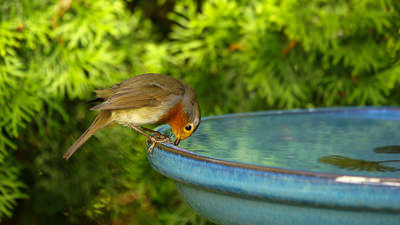
What Do Robins Eat?
There are dozens of bird species called robins, but the relationship between these different birds is often less rooted in shared evolutionary history and more in passing resemblances. The two most prominent species are the European and American robins — but their relationship to one another is actually quite distant, and the closest connection between them is the fact that they both bear a bright orange patch on their chest. Despite that, these birds tend to have similar diets and employ similar tactics for both catching prey and eluding predators.
Both European and American robins are opportunistic omnivores who split their diet roughly between meat and vegetable matter and who adjust their intake of different food sources depending on the time of the year. The environments they live in usually consist of four distinct seasons, and they appear to adjust their diets based not just on availability but also on situational demand. Despite their physiological differences and different environments, both robin species have developed their own seasonal habits.
Spring and summer are months that are rich in protein-heavy meals, and both robin species make as much of that time as possible. American robins have as many as 100 different invertebrate species to feed on, and these range from earthworms and snails to millipedes and centipedes to termites and spiders. In the peak of spring, soft and hard invertebrates constitute as much as 90% or more of a robin’s diet with fruits representing 10% or less. In the winter, those numbers will flip completely.
2,240 People Couldn’t Ace This Quiz
Think You Can?
Breeding behavior is situated around the feast and famine cycle of the typical robin. Eggs can begin to hatch between April and August, leaving most baby robins going through their most vulnerable and important growth phase when insects and invertebrates are most plentiful. Both mother and father will care for baby robins, which they feed on a diet of worms that they break down for easier digestion. These attentive parents will often feed their young as many as a hundred times in a single day.
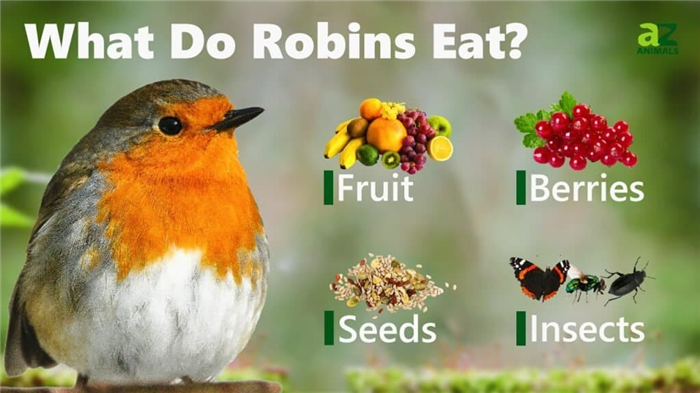
Robins are opportunistic omnivores who split their diet roughly between meat and vegetable matter and who adjust their intake of different food sources depending on the time of the year.
What Do Robins Eat in the Winter?
That depends on the robin. Some American robins migrate south as far as Mexico and Central America in the winter, while some European robins will venture into the Mediterranean for warmer conditions. But most robins of both species stay within the same general habitat they occupy throughout the year. As many insects go into hibernation, robins are left with fewer food sources to draw from. Throughout the winter, wild berries will take up the majority of a robin’s diet.
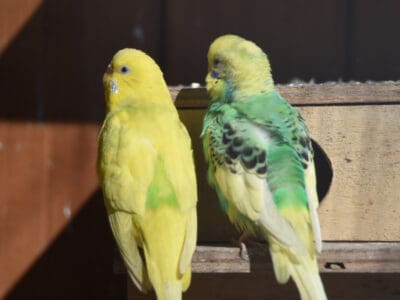
The Best Nest Boxes Birds Will Actually Use for 2022
This is all the time of year when you’re most likely to find robins at a feeder in the yard. They don’t have an appetite for most seeds, they will venture out in the yard for sunflower seeds. They’re also a fan of nuts, suet, and cultivated fruit. If food is particularly scarce, robins may abandon their normally territorial nature to gather in flocks. These flocks will then situate themselves around wooded areas with a high concentration of wild berries.
Robins eat a diet that includes:
- Worms
- Insects
- Spiders
- Small reptiles
- Cultivated fruits
- Wild berries
How Do Robins Hunt For Food?
Despite being prevalent throughout both the United States and Europe, robins aren’t all that common a sight in the yard or around feeders. That’s because humans often have little to offer them. Worms, snails, and other invertebrates can be hunted at low energy cost while providing high levels of protein intake — and that’s the value they won’t find in a traditional bird feeder. And while they’d much prefer meat over fruits, there is no lack of wild berries during the colder months.
For migrating robins, fruits offer the energy they need to cross long distances over the course of a few months. During mating and nesting season, foraging responsibilities will be split between both the male and female of a pairing — and robins will typically forage together in flocks once the chicks have left the nest. In pursuit of their preferred prey, robins have two great tools at their disposal: their eyes and their ears. Both senses are especially strong and are used in conjunction with one another. Robins forage on the ground, typically picking through leaves and other carpet detritus in search of bugs and invertebrates. They’ll tip their heads to the side until they hear movement and then zero in on the location with their precision eyesight. They’ll use both their beaks and their feet to dig away underneath themselves in pursuit of prey.
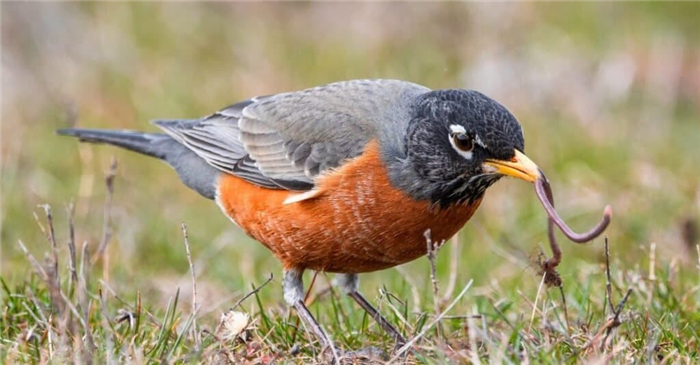
A Robin hunting earthworms in the grass.
What Animals Eat Robins?
The trifecta of threats that most songbirds have to deal with is true for robins as well. Cats, snakes, and birds each offer their own challenge to European and American species. Hawks, shrikes, and owls are all large and terrifying predators in their own right, but even smaller birds like crows and blue jays can pose a threat to baby robins and to robin eggs.
Rat snakes rank among the most common and dangerous serpents to prey on robins. They’re exceptional climbers who can rely on their ability to sense chemicals to hunt. They’re also voracious predators who will clear a nest of eggs, chicks, and potentially even adults in one sitting.
But robins are most vulnerable when they’re on the ground. They typically hop across the ground while foraging for prey, and that leaves them vulnerable to domesticated pets like dogs and cats. Wild mammals present their own threat in the form of raccoons and foxes. The former is especially dangerous because of their proficiency at climbing.
Share this post on:
AZ Animals Staff
AZ Animals is a growing team of animals experts, researchers, farmers, conservationists, writers, editors, and — of course — pet owners who have come together to help you better understand the animal kingdom and how we interact.
FAQs (Frequently Asked Questions)
What can I feed robins in my yard?
Robins are picky eaters who usually have abundant food in the wild. Moreover, they show little interest in many of the seeds that other birds feed on. The best way to lure them in is with fruit as bait. Raisins, apples, grapes, and strawberries will gather the attention of robins, especially in the winter. They’re also fond of suet.
What household food do robins like?
You can feed robins with the fruit right out of your fridge. Just keep in mind that these stubborn birds do their foraging on the ground and don’t have much experience with feeders. As a result, you might get the best results by simply leaving pieces of fruit on the ground.
Do robins eat fruit?
While robins will always choose a high protein food source like worms and beetles over fruit, options become significantly more limited in the winter. Over 90% of a robin’s diet in the colder months may consist of fruit — and they’re known to feed on both wild berries and cultivated crops like apples.
What Do Robins Eat?

Melissa Mayntz is a bird expert, certified Master Naturalist, writer, and author with over three decades of experience. She’s published in several national magazines, including National Wildlife Magazine, Bird Watcher’s Digest, and WildBird Magazine. Melissa has studied hundreds of bird species around the world, traveling to Mexico, Central America, the Caribbean, the central Pacific, the Middle East, and more on birding expeditions.
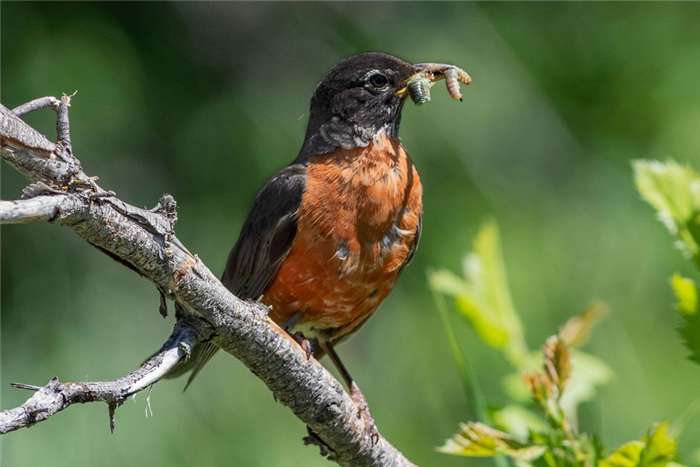
The Spruce / jskbirds
Robins are familiar feathered visitors, but even though they are one of the most common backyard birds, they don’t often visit bird feeders. So what do robins eat, and how can birders provide nutritious and attractive foods for robins?
Natural Foods for Robins
American robins are widespread thrushes, closely related to bluebirds, hermit thrushes, wood thrushes, and Townsend’s solitaires. Like most other thrushes, robins are omnivorous and have a wide-ranging, opportunistic diet that changes with the seasons, habitat, and general availability of different food sources. A robin’s typical diet consists of 40 percent insects and 60 percent fruits, with popular foods such as:
- Earthworms, insect larvae, grubs, caterpillars, and snails
- Spiders, beetles, grasshoppers, termites, crickets, and other insects
- Berries such as blueberries, mulberries, winterberries, juniper, honeysuckle, and holly
- Small tree fruits including cherries, crabapples, chokecherries, dogwood, and hawthorn
- Vine fruits such as wild and domesticated grapes
In addition to these foods, American robins have also been recorded as eating eggs, small snakes, frogs, skinks, and small fish, depending on where they are foraging and what they can catch.
In spring and early summer, robins eat more mollusks and insects to provide adequate calcium for egg formation and protein for feeding hungry hatchlings. In late summer and fall, berries and fruits are more abundant. In winter, robins will eat whatever foods they can find, which often includes leftover fruits and berries still hanging on plants, or else the birds will migrate to where food sources are more readily available.
The time of day when a robin eats has also been noted as affecting the bird’s diet. Earlier in the day when the ground is still wet, these birds find more worms and grubs. Later in the day, robins eat more berries and fruits.
What to Feed Robins in the Yard
Because American robins don’t eat many foods that are common in feeders, providing natural food sources is the best way to attract these birds with tasty treats. In addition to basic bird-friendly landscaping, consider options such as:
- Use berry-producing juniper hedges for a fence or privacy barrier
- Plant crabapple or cherry trees for their beautiful spring blossoms and abundant fruit
- Add a grapevine along a fence to cover the structure and provide a food source
- Use bird-friendly mulch or leave leaf litter intact for foraging robins
- Plant holly bushes in landscaping beds or underneath trees
- Reduce insecticide use to encourage birds to naturally control pests
- Water the lawn in the early morning to bring earthworms to the surface
- Keep grass mowed shorter to allow robins to forage more easily
These few steps can provide a bountiful natural feast for robins, but with the right foods, they will also visit feeders. Provide chunks of fruit, such as apples and pears, as well as softened raisins or cranberries for the birds to sample. Suet chunks, nuggets, or shreds can also tempt American robins, and they will sample peanut hearts, hulled sunflower seed, mealworms, and jelly.
Use broad, open tray, platform, or dish feeders to accommodate robins at feeding stations. Because these are larger birds, they are more comfortable at larger feeders, and because they may travel in flocks, it is best to have plenty of space for robins to visit. Ideally, feeders should be placed on or near the ground, as these birds are more comfortable foraging on the ground. For a fun option, try a bird feeder garland on trees or shrubs where robins are used to feeding, and they will happily enjoy the decorative treat.
What American Robins Won’t Eat
While there are many things robins will sample in the yard, it is equally important to note what foods they won’t eat. American robins do not eat many seeds, and won’t regularly visit feeders offering Nyjer seed, hummingbird nectar, mixed birdseed, cracked corn, safflower seed, or whole peanuts. They may initially try these foods, but aren’t likely to return and be frequent guests if other foods are available. Of course, birders who offer a wide range of foods can supply not only robins’ favorite options, but also foods to attract many other birds as well.
While the American robin is one of the most popular and familiar birds in North America, it must be noted that the European robin is also one of the most popular and familiar birds throughout Europe. While the European robin is not a thrush and is not closely related to the American robin, it does share similar dietary preferences. The same types of natural foods, including worms, insects, fruit, and berries, will be just as attractive to European robins as they are to American robins. It is best, however, to choose plant varieties that are native to each birds’ range to attract and feed different robins.
Robins eat a wide variety of foods, and birders who are aware of these birds’ broad diets can more easily offer many different foods in their yard to attract and nurture robins all year long.
What do robins eat?

Robins are a cheerful sight in any garden, singing late into the night and scouting for something to eat. But what is it they’re looking for?
What do robins eat?
Robins feed on insects (especially beetles) and worms. You might notice one following you about as your dig up your garden hoping to nab a few worms as you unearth them.
Robins can also eat fruit, seeds, suet, crushed peanuts, sunflower hearts and raisins. They particularly enjoy mealworms.
Robins are fans of insects and worms, but also feed on fruit and nuts in the wild.
Credit: Hermann Brehm / naturepl.com
How to feed robins in your garden
Putting food out and waiting to see which birds stop by for their tea is always a treat, but not all birds eat the same foods or the same way. Here’s how to make sure you’re visited by Mr Robin Redbreast.
Ground feeding trays
Robins are natural ground feeders, so feeding trays are ideal. Make a mixture of bird seed, sunflower hearts and mealworms, sprinkle it out on a tray and wait for the robins to arrive.
As they’re such fans of mealworms, you can give them an extra helping hand by soaking dried mealworms in water, giving the robins some valuable moisture from the food.
Bird tables
Like ground feeding trays, bird tables give robins an easy place to eat.
Pop some fruit and mealworms out on the platform and watch them tuck in. You could also have a go at making your own bird cake or food bars using melted suet or lard. Just pour it into a mixture of seed, raisins and nuts, let it cool and place it onto the table.
You can leave food on an open bird table but make sure you remove it if it gets wet. Damp food is susceptible to mould and bacteria which can make birds ill. Covered bird tables are best as their roofs help keep food dry, protect smaller birds from predators, and can make it harder for wood pigeons to snaffle all the food!
How to feed robins
Robins are ground feeders, which means the best way to entice them is to buy a bird table away from the risk of cats, preferably one that is covered and has plenty of place for robins to perch. Put out some fruit, seeds, suet, and live or dried mealworms (if you are using dried it is best to soak them in water first), and wait for the robins to arrive!
Fat balls or bars can be a great way to entice robins. Melt some suet or lard and mix it with fruit, nuts and seeds, then leave the hardened balls or bars on your feeder.
In addition, make sure you put out a dish of clean water – robins need to stay hydrated and clean.
